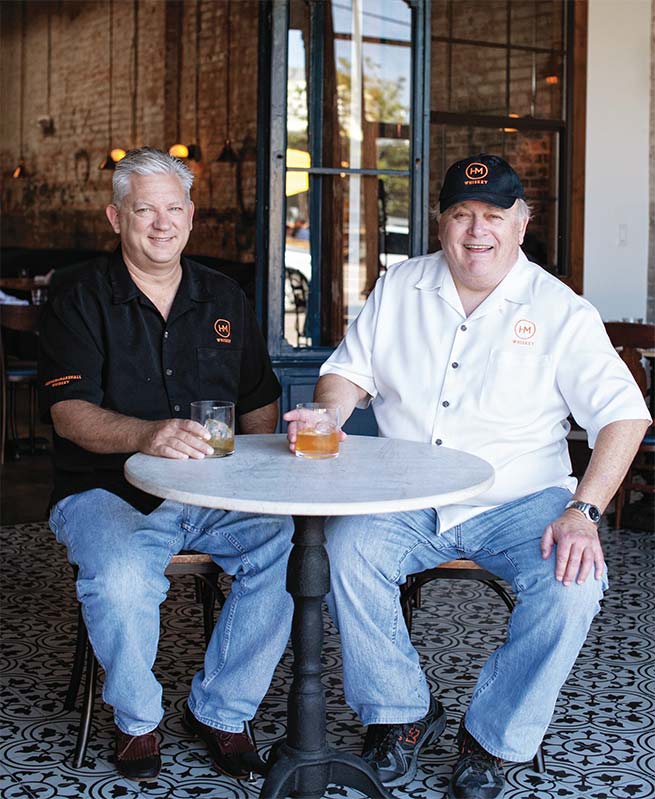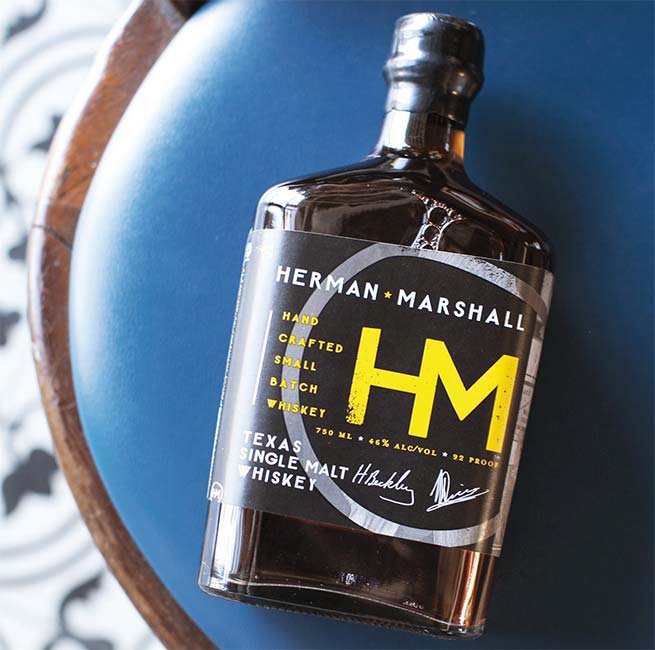
Herman Beckley (left) and Marshall Louis.
Story by Cody Neathery • Photography by Desiree Espada
Lowering a copper rod called a “whiskey thief ” into a 53-gallon white oak barrel, distiller Herman Beckley captures a sample of his unfinished bourbon. He pours the fiery liquid—clocking in at 118 proof—into my glass and gives fair warning. Exhale after swallowing to dissipate the burn.
Beckley, along with business partner Marshall Louis, are the namesakes and co-owners of Herman Marshall, makers of bourbon, rye and single-malt whiskies. Though the word “whiskey” is derived from a Gaelic term meaning “water of life,” Beckley likens his spirits’ flavors to candy. To prove his point, he pours a smidgen of bourbon into the palm of my extended hand and instructs me to quickly rub both hands together to “get a little heat going.” Once the slippery liquid dries, I raise my cupped hands and inhale. Just as Beckley says, the residue has a sugary sweet aroma. Like a salted caramel.
If driving to the distillery, you might question your directions. The business is unceremoniously sandwiched between industrial buildings and warehouses in the Dallas suburb of Garland. “Garland is a place where you make things,” says Beckley, summing up the neighborhood.
Ironically, hard liquor cannot legally be sold within the Garland city limits, which is of no concern to Beckley and Louis. “I know some of our other craft guys put a lot of effort into public tours, and I think that distracts them from their core of business,” says Beckley. While others are fighting laws to allow alcohol sales at their distilleries and breweries, the partners are laser-focused on production and distribution. “Find a way to get a retailer partner to order another hundred cases, and who cares about selling bottles after a tour?”
Sixteen years ago, Beckley and Louis discovered their mutual interest in whiskey at a North Dallas Starbucks. They were part of a group that got together (and still gets together) on weekends. Beckley has a background in the computer software industry. Louis, who hails from South Africa, worked in commercial construction, but his family history includes winemaking.

Herman Marshall’s Texas Single Malt Whiskey.
Those coffee shop chats transformed into ideas with more substantial goals, like forming a legal distillery. The men began making their first batches (which were “absolutely awful”) in Beckley’s garage in 2004. By 2008, they had refined their product and in 2012, they opened their distillery doors.
“No one knew we existed in those first years,” says Beckley. Not until their bourbon took a silver medal at the 2013 American Distilling Institute’s Spirit Competition. “That catapulted us into the crosshairs of a distributor.”
From the beginning, Beckley and Louis have been set on adhering to the historical methods of production. “We make very simple uncomplicated recipes, with very simple uncomplicated technique, which is how whiskey was made in the late 1700s and early 1800s,” says Beckley. Most of the corn for their bourbon and single-malt whiskies is grown in the McKinney area, with supplemental harvests coming from the Texas Panhandle. Their rye and barley come from North Dakota.
Their production room mimics a giant chemistry lab, but with barrels stacked one upon another. The grain is ground to a specified density and cooked. “When you pitch the yeast, you expect that it’s going to do its job,” says Beckley. “Sometimes it refuses to cooperate so you increase temperature or decrease temperature. At the end before you distill the mash, it should have the flavor of what you expect. It has to have a bite to it, a certain amount of sourness and consistency.”
The cooked mash ferments for seven days in open-air tanks, which are handmade onsite from Louisiana swamp cypress. (Beckley, whose hobby is woodworking, keeps a shop in the back of the distillery.) They use a unique still, a hybrid Scottish-style pot built to their own specifications. “The process is very traditional with no computerization and no electronics,” says Beckley. “We found that this technique of distillation yields a smooth distillate on the second pass and that is what gets put into barrels.”
Their chosen timeline for aging their spirits rests at four years. “Anything longer than that and it starts to take on strong wood notes from the barrels. . . . That may appeal to some people, but we’re trying to focus on a particular flavor profile that Marshall and I agreed upon, and that’s what we aim for.”
To prevent cloudiness, major brands typically choose to “chill filter” their product which removes proteins that solidify at colder temperatures. Staying true authenticity, Beckley and Louis opt not to go this route.
Today, they produce over 100,000 bottles a year and can be found in over 3,000 stores, bars and restaurants. “We outperform a lot of major brands,” says Beckley. “You’ll see us on a menu before Woodford or Knob Creek.”
Beyond their three mainstay whiskies, be on the lookout for their collaboration with Lakewood Brewery—a limited release called Temptress. Riding the craft beer wave, Beckley has turned the brewery’s Temptress beer into whiskey. He says they’re the first to develop a local craft whiskey from a local craft beer.
“Our goal,” says Beckley, “is to be very authentic in our technique and have a smooth whiskey with a lot of flavor. Smoothness is the important thing though and the most difficult to create. It takes know-how and practice.”
RECIPES











